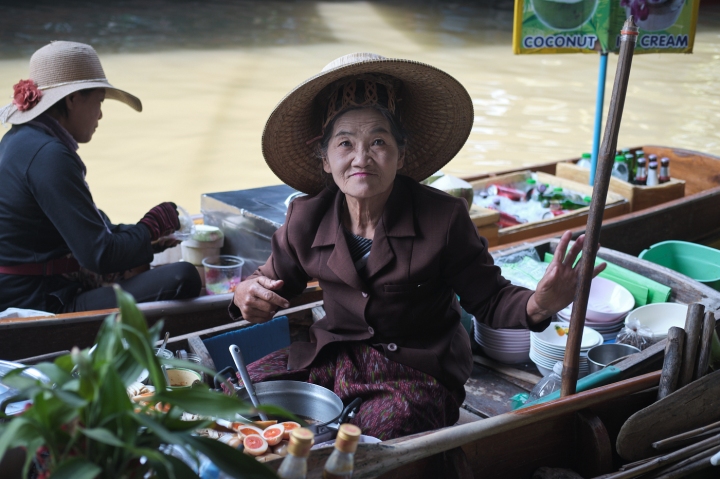
On our third day in Thailand, we had a full-day itinerary planned after spending our first two days at a slow pace in Bangkok warding off any severe jet lag. The schedule for the day had us driving out of Bangkok to explore the Mae Klong Railway Market, heading over to the Damnoen Saduak Floating Market next, and then finishing our day back in Bangkok to experience the Grand Palace.

I had read a lot about the Mae Klong Railway Market before we arrived, and was very interested in seeing how a train could possibly make its way through the middle of a live and bustling marketplace. Once we arrived, I was shocked by how close the stalls and stands were to the railway. My shock was quickly distracted by the sights, smells, and sounds of the lively market.


After spending some time exploring the market for an hour, we noticed a buzz in the air from the marketplace and its stalls. In an instance, the awnings were retracted, and the people of the marketplace began to quickly pull their wares away from the train track. We looked towards the commotion and the direction of tourists pointing cameras, and saw the light of the oncoming train. The train was moving very slowly, but it was still a little hair-raising for it to pass so close.

After a little more time exploring the Mae Klong Railway Market, we made our way around the Damnoen Saduak Floating Market. Damnoen Saduak is one of the most popular and well known floating markets in all of Thailand. The market is built along the Damnoen Saduak Canal, which was constructed in 1868 to connect the Mae Klong and Tha Chin Rivers. This was a major transportation line before development of roads in Thailand a century later.
The marketplace is still a full operation, but is geared up for tourism and visitors that make the 100-kilometer trip out from Bangkok.


After exploring the market, I wanted to grab a quick coffee before making our way to lunch. There was an old style Thai coffee stall next to the floating market that looked interesting.

It was a warm and humid day, so iced coffee seemed like a nice option. At 30 bhat ($1.00), it was an easy sell. Oliang, or iced black coffee, is a popular drink in Thailand. It also very common to have oliang with milk and/or sweeteners. Personally, I only drink black coffee, but our guide ordered one with condensed milk, so I got to see the process for both.

Traditional Thai coffee is made using a tungdtom filter, which is like a cotton sock on a metal frame. The grounds are added to the tungdtom and then boiling water is poured on the grounds into a carafe. The bag is then steeped for 5-10 minutes like tea, before being prepped for its final delivery.


After leaving the floating market behind, we had lunch, and then made our way back to Bangkok to visit the Grand Palace. The Grand Palace has been the official house of the kings of Siam since 1782, and is a fascinating complex of structures.

To finish our day, we left the Grand Palace behind and walked around Chinatown. The marketplace surrounding Chinatown was just as impressive as the Mae Klong Railway Market and Damnoen Saduak Floating Market. Chinatown quite literally has a little bit of everything. It was the perfect way to complete our stay in Bangkok. The following day, we’d be making our way out of town for a trip to Kanchanaburi.



One thought on “Old Style Thai Coffee at Damnoen Floating Market – Bangkok, Thailand”